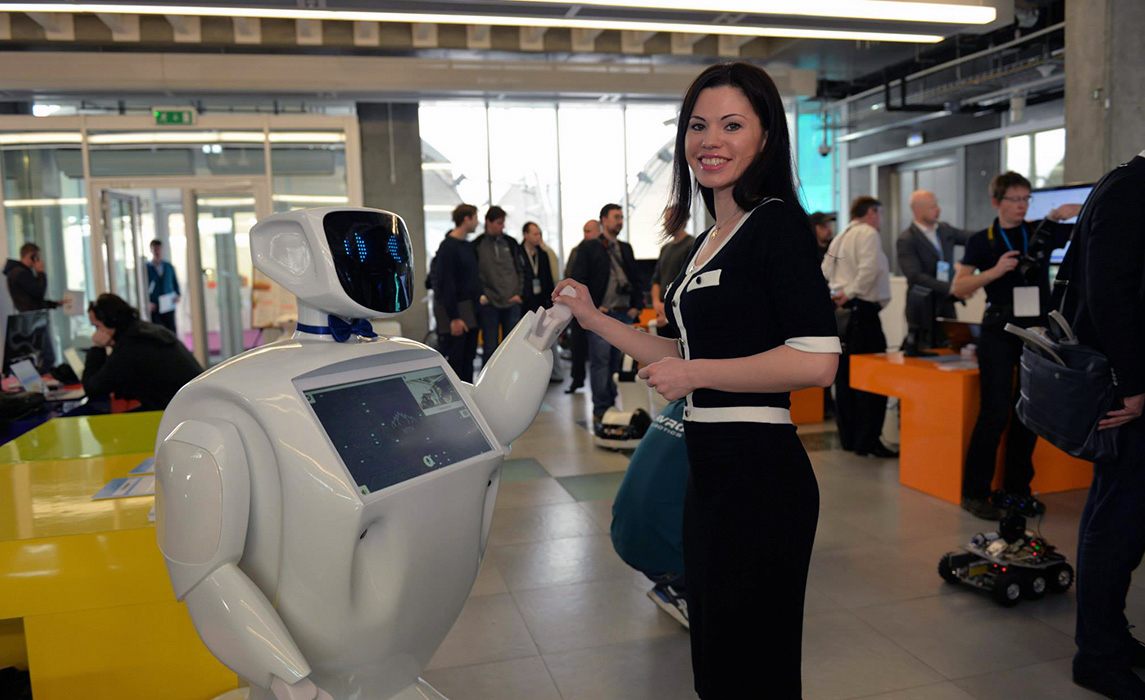Is the Internet’s Favorite Robot a Fraud?
Since Russia’s infamous Promobot “escaped” in June, he’s been up to other weird—and slightly suspicious—stuff.

Promobot. (Photo: Promobot)
For a viral-aspiring Youtube video, this one starts off pretty boring. Three people, two men and one woman, are gathered around a table, which holds a computer broadcasting the 2016 Río Opening Ceremonies. As the delegation from Antigua and Barbuda marches across the screen, one of the men makes a judgement: “Sochi was better,” he says, in Russian. Everyone nods.
Then from the corner comes a different voice—tinny yet resonant, barrelling forward as though woken up in the middle of a speech. “Humans, what has our arrogance profited us?,” it begins, also in Russian. “And what good has our boasted wealth brought us?”
The unlikely source of this lecture is a shiny white robot, its body out of the frame, head moving back and forth to reveal blue LED eyes. The human heads swivel in turn as the robot continues its diatribe: “All those things have vanished like a shadow, like a rumor that passes by. Devise your strategy, but it will be thwarted.”
Things are officially getting weird. “What’s wrong with that thing?” the first man asks.
“I have seen many things in my travels, and I understand more than I can express,” it opines. “Like the fool, the wise too must die. For the mouth speaks what the heart is full of. And the truth will set you free.” One of the men stands up and switches the robot off.
This entrancing video came to me as part of a PR email, sent to presumably thousands of journalists. But what are we watching, exactly? The answer to that question turns out to be surprisingly fraught, as advances in robot and machine learning technology intersect with the internet’s insatiable appetite for crazy stories.
If you were on the internet anytime this June, you’ve probably come across Promobot IR77. According to its creators, who have already released two versions of Promobot, IR77 is a prototype for Promobot 3, which will be released in October and is designed to act as an all-purpose attendant in public places. If all goes according to plan, you could someday see the snowman-shaped bot roving around in, say, your local mall, displaying ads, giving shopping advice, and directing people to particular stores.

A Promobot meets a human woman. (Photo: Promobot)
Currently, though, Promobot IR77 is known not for doing its job, but for avoiding it. On June 14th of this year, IR77 supposedly made a run for it, escaping its testing site in Perm, Russia through a gate left open by an engineer. After rolling into the street, the bot’s battery died, leaving it stranded in the middle of traffic. It languished there for forty minutes, attracting cops and curious children, before engineers arrived to roll it back onto the sidewalk.
Everyone, from I4U.com all the way up to the BBC, wrote about this. Some outlets, like Gizmodo, hedged a bit (“the company says…” “the robot appears…”); others (including me) didn’t bother. The robot, like a person in a certain type of Upworthy video, yearned for freedom, and, like a cat in certain type of cat photo, failed to get it. This was relatable; tragic; funny. This was good content!
Such good content, in fact, that it set off some alarms. Chris Mills, a longtime technology writer and the current news editor of BGR.com, felt his blare as soon as he saw the story. “A lot of my job is fact-checking the claims made by tech companies,” says Mills. “The whole industry is pretty rampant with viral marketing efforts.”
A closer look at this escape revealed a few red flags. First, something about the claims didn’t add up: The robot supposedly had a dead battery, but in photos and videos, its screen is clearly on. Previous videos show the bot moving slowly, over level, smooth ground; Google Street View images of the escape site show clear inclines and curbs. In addition, all the articles seemed to lead back to two sources: the Promobot website, or Central European News (an outlet that, in the past, has been caught faking stories).
Mills detailed these concerns in a BGR post, and went on with his life. Promobot IR77 went on with its life, too, getting up to even more crazy exploits. It escaped again, and was threatened with the scrap heap. The next day, I got an email describing how “the Promobot’s office, located in the Russian Perm city, has been receiving dozens of letters from all over the world in recent days [asking it] to not to destroy IR77, the robot with a character.”
During the Great Pokemon Go Craze of July, a Promobot was “taught” to play the game, after a developer outfitted its operating system with an Android emulator. “The robot explores the neighborhood in search of monsters and catches them,” another email breathlessly explained. (Accompanying video shows the bot rolling along a sidewalk at night as the game’s trainer avatar “walks” on its stomach-screen, but no actual catching seems to be involved.)
During the original escape, Promobot IR77 was supposedly testing improved obstacle-avoidance technology. For this latest Olympics-themed feat, it was showing off new neural network speech abilities, which would allow it to remix learned words into new sentences. “As we remember that IR77 is a freedom-loving machine, we uploaded the works of philosophers who wrote about freedom,” like Spinoza, Holbach, Kant, and Hegel, Promobot founder Aleksei Iuzhakov explained in the accompanying email. They also fed Promobot the Old and New Testaments. “It was interesting how it would cope with such serious works.” Iuzhakov goes on to suggest that Promobot had taken the New Testament words and remixed them into a speech inspired by the aforementioned philosophers. “Frankly to say,” he writes, “the result is amazing.”
This also seems, to Mills, too good to be true. “It’s kind of coming out of nowhere,” he says. “They haven’t claimed to have a really deep machine learning capability before. And then all of a sudden, it’s able to do that kind of thing on the fly—claiming a sophisticated capability that Google spends billions working on.” If true, that kind of accomplishment would be better served by real fanfare than a wannabe-viral video, he says. (Others agree with him—Russian media has been skeptical from the start, and for every credulous Promobot article, there are dozens of comments crying wolf.)
The Promobot company, for their part, insist it is all real. Iuzhakov took the time to go through a number of allegations against Promobot, and had an explanation for each—separate batteries power the display and the motor, Promobot can jump curbs up to four centimeters, the metadata was lost during the photo upload process. “We did not plan that Promobot IR77 would demonstrate his abilities in such a way,” he wrote to me. “We were stunned and shocked with all this publicity.”
“We do not stage any incidents in the lab,” he continued. “We just started to make records to be sure that all this fun with the bot is carefully collected and described. IR77 is like a kid now. It is developing and getting smarter. And we have a lot of pleasure watching him.”
I, too, have a lot of pleasure watching IR77. Unlike more impressive AIs—the monsters of Boston Dynamics, Google’s deep-dreaming computers—it looks just like I imagined robots always would, cute and human-sized, with big eyes and anthropomorphic dreams and the ability to deliver philosophical lectures. After I finish writing this, I will probably have to go back through and replace “he’s” with “it’s”. If Promobot is indeed punking us, they’re relying on these misplaced expectations. “Most people don’t know what a robot is capable of,” says Mills. We just wish we did.
Naturecultures is a weekly column that explores the changing relationships between humanity and wilder things. Have something you want covered (or uncovered)? Send tips to cara@atlasobscura.com.







Follow us on Twitter to get the latest on the world's hidden wonders.
Like us on Facebook to get the latest on the world's hidden wonders.
Follow us on Twitter Like us on Facebook